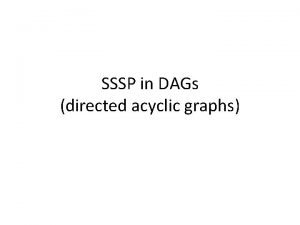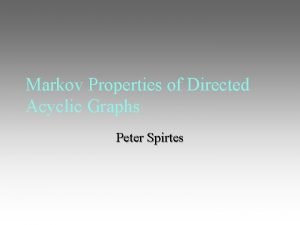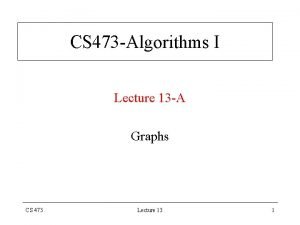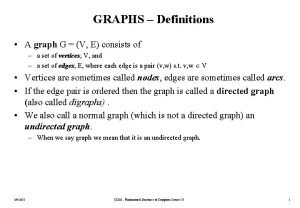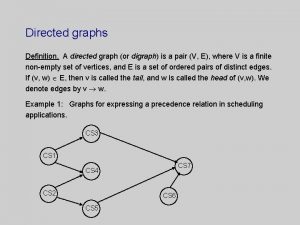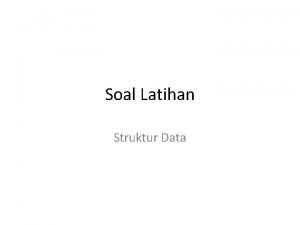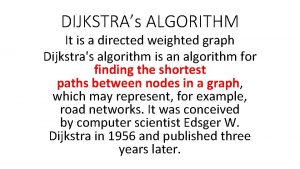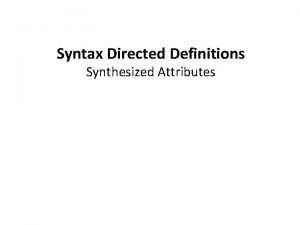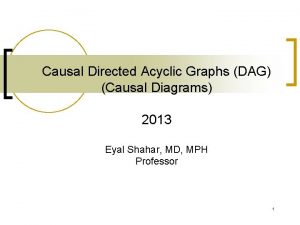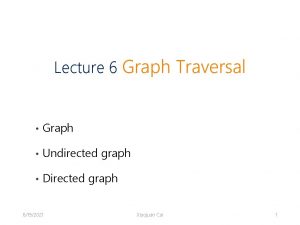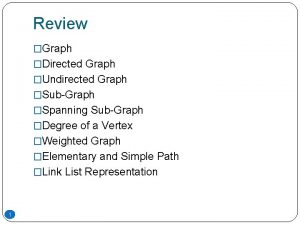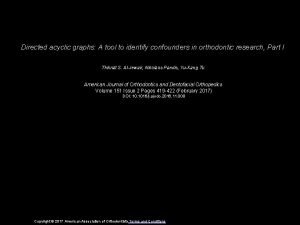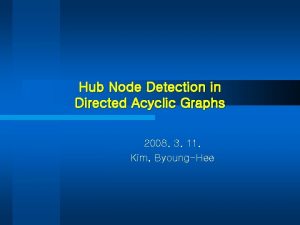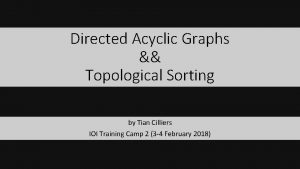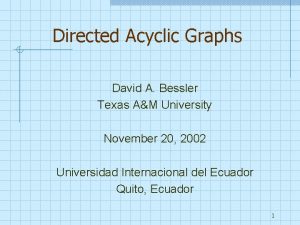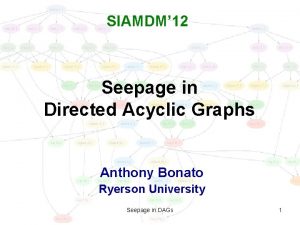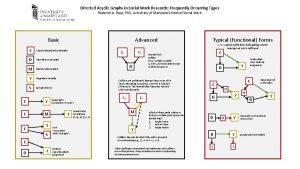Unit V Directed Acyclic Graph DAG 1 DAG




















- Slides: 20

Unit V - Directed Acyclic Graph (DAG) 1

DAG Representation of Basic Blocks • A DAG for a basic block is a directed acyclic graph with the following labels on nodes: – Leaf nodes represent identifiers, names or constants. – Interior nodes represent operators. – Interior nodes also represent the results of expressions or the identifiers/name where the values are to be stored or assigned. • DAGs are useful data structures for implementing transformations on basic blocks. • Directed Acyclic Graph (DAG) is a tool that depicts the structure of basic blocks, helps to see the flow of values flowing among the basic blocks, and offers optimization too. 2

Algorithm for construction of DAG Input: A basic block Output: A DAG for the basic block containing the following information: 1. A label for each node. For leaves, the label is an identifier. For interior nodes, an operator symbol. 2. For each node a list of attached identifiers to hold the computed values. Case (i)x : = y OP z Case (ii)x : = OP y Case (iii)x : = y 3

Contd… Method: Step 1: If y is undefined then create node(y). If z is undefined, create node(z) for case(i). Step 2: For the case(i), create a node(OP) whose left child is node(y) and right child is node(z). (Checking for common sub expression). Let n be this node. For case(ii), determine whethere is node(OP) with one child node(y). If not create such a node. For case(iii), node n will be node(y). 4

Contd… Step 3: Delete x from the list of identifiers for node(x). Append x to the list of attached identifiers for the node n found in step 2 and set node(x) to n. 5

Applications of DAG • To detect common sub expressions. • To determine which identifiers have their values used in the block. • To determine which statements computed values that could be used outside the block. 6

Example - 1 • Represent the following statement by means of DAG i=i+10 : = i + i 10 7

Example - 2 • Represent the following statement by means of DAG a=b*-c+b*-c : = a + * b c 8

Example - 3 • Represent the following three address statement by means of DAG t 0 = a + b d + t 1 = t 0 + c + + d = t 0 + t 1 t 1 t 0 + + c c t 0 + a b a b 9

Exercise • Represent the following sequence of three address statements (basic block) by means of DAG. t 1=4*I t 2=a[t 1] t 3=4*I t 4=b[t 3] t 5=t 2*t 4 t 6=prod+t 5 prod=t 6 10

Generating Code from DAG • Advantage: – From a DAG, we can easily see how to rearrange the order of the final computation sequence than we can start from a linear sequence of three-address statements or quadruples. 11

Contd… • Rearranging the order: The order in which computations are done can affect the cost of resulting object code. • For example, consider the following basic block: t 1 : = a + b t 2 : = c + d t 3 : = e – t 2 t 4 : = t 1 – t 3 12

Contd… • Generated code sequence for basic block: MOV a , R 0 ADD b , R 0 MOV c , R 1 ADD d , R 1 MOV R 0 , t 1 MOV e , R 0 SUB R 1 , R 0 MOV t 1 , R 1 SUB R 0 , R 1 MOV R 1 , t 4 13

Contd… • Rearranged basic block: Now t 1 occurs immediately before t 4. t 2 : = c + d t 3 : = e – t 2 t 1 : = a + b t 4 : = t 1 – t 3 14

Contd… • Revised code sequence: MOV c , R 0 ADD d , R 0 MOV e , R 1 SUB R 1 , R 0 MOV a , R 1 ADD b , R 1 SUB R 1 , R 0 MOV R 0 , t 4 • In this order, two instructions MOV R 0 , t 1 and MOV t 1 , R 1 have been saved. 15

A Heuristic ordering for Dags • The heuristic ordering algorithm attempts to make the evaluation of a node immediately follow the evaluation of its leftmost argument. 16

Contd… • The algorithm shown below produces the ordering in reverse. Algorithm: 1. while unlisted interior nodes remain do begin 2. select an unlisted node n, all of whose parents have been listed; 3. list n; 4. while the leftmost child m of n has no unlisted parents and is not a leaf do begin 5. list m; 6. n : = m 7. End 8. End 17

Contd… • Example: Consider the following DAG: 18

Contd… • Initially, the only node with no unlisted parents is 1 so set n=1 at line (2) and list 1 at line (3). • Now, the left argument of 1, which is 2, has its parents listed, so we list 2 and set n=2 at line (6). • Now, at line (4) we find the leftmost child of 2, which is 6, has an unlisted parent 5. Thus we select anew n at line (2), and node 3 is the only candidate. We list 3 and proceed down its left chain, listing 4, 5 and 6. This leaves only 8 among the interior nodes so we list that. • The resulting list is 1234568 and the order of evaluation is 8654321. 19

Contd… • Code sequence: t 8 : = d +e t 6 : = a + b t 5 : = t 6 – c t 4 : = t 5 * t 8 t 3 : = t 4 – e t 2 : = t 6 + t 4 t 1 : = t 2 * t 3 • This will yield an optimal code for the DAG on machine whatever be the number of registers. 20
 A vertex is if its indgree(v)=1 and outdegree(v)=0.
A vertex is if its indgree(v)=1 and outdegree(v)=0. Properties of directed acyclic graph
Properties of directed acyclic graph Connected acyclic graph
Connected acyclic graph Syntax directed definition and syntax directed translation
Syntax directed definition and syntax directed translation Acyclic dependencies principle
Acyclic dependencies principle Za 30 dag orzechów pistacjowych zapłacono 15,75
Za 30 dag orzechów pistacjowych zapłacono 15,75 Hvilken dag er det i dag
Hvilken dag er det i dag Bi sang
Bi sang G(v e)
G(v e) Graph definition
Graph definition Diketahui float a 5
Diketahui float a 5 Directed weighted graph
Directed weighted graph Unit 10, unit 10 review tests, unit 10 general test
Unit 10, unit 10 review tests, unit 10 general test Bridge graph
Bridge graph Wait-for graph
Wait-for graph Line segment geometry
Line segment geometry Child directed speech definition
Child directed speech definition Input string
Input string Self-directed search manual
Self-directed search manual Self-directed search
Self-directed search Romeo and juliet balthasar
Romeo and juliet balthasar
